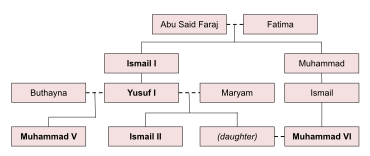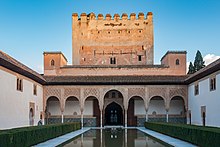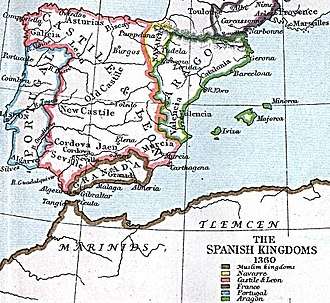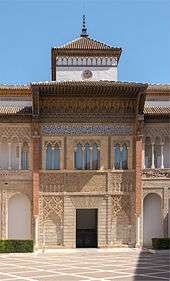Muhammad VI of Granada
Abu Abdullah Muhammad VI ibn Ismail (Arabic: أبو عبد الله محمد بن إسماعيل, 1332 – 27 April 1362), also known by his Castilian nickname el Bermejo ("The Red One") and the regnal names al-Ghālib bi 'llāh (Arabic: الغالب بالله, lit. 'Victor by the Grace of God') and al-Mutawakkil ʿalā 'llāh (Arabic: المتوكل على الله, lit. 'He who relies on God'), was the tenth Sultan of the Emirate of Granada. A member of the Nasrid dynasty, he ruled for a brief period between June or July 1360 and April 1362.
| Muhammad VI | |||||
|---|---|---|---|---|---|
| Sultan of Granada | |||||
| Reign | June/July 1360 – April 1362 | ||||
| Predecessor | Ismail II of Granada | ||||
| Successor | Muhammad V of Granada | ||||
| Born | 1333 Granada (presumed) | ||||
| Died | 25 April 1362 Tablada, near Seville | ||||
| |||||
| Dynasty | Nasrid | ||||
| Father | Ismail ibn Abdullah | ||||
| Religion | Islam | ||||
A second cousin and brother-in-law of both Muhammad V and Ismail II, he led a coup that deposed the former and enthroned the latter in August 1359. He increasingly held the power of government during Ismail's rule, and in June or July 1360 he killed the new Sultan and took the throne to himself. Muslim chronicles portrayed him negatively, describing him as a tyrannical ruler with coarse manners. In October, he allied himself with Peter IV of Aragon against Peter I of Castile in the War of the Two Peters, but had to face Castile alone when Aragon agreed to a separate peace in May 1361. Castile allied itself with Muhammad V who returned from exile in August. The war against this coalition began with partial successes for Muhammad VI, but from February 1362 onwards Peter I and Muhammad V won a string of major victories. In 13 April Muhammad VI fled Granada, allowing his rival to retake the throne. The desperate Muhammad VI then unexpectedly threw himself at the mercy of Peter I in Seville. However, the Castilian king—still outraged at his previous alliance with Aragon—decided to personally kill him with a lance on 27 April and send his severed head to Granada.
Geopolitical background
The Emirate of Granada was the last Muslim state on the Iberian Peninsula, founded by Muhammad I in the 1230s.[1] Through a combination of diplomatic and military manoeuvres, the emirate succeeded in maintaining its independence, despite being located between two larger neighbours: the Christian Crown of Castile to the north and the Muslim Marinid Sultanate in Morocco. Granada intermittently entered into alliance or went to war with both of these powers, or encouraged them to fight one another, in order to avoid being dominated by either.[2] From time to time, the sultans of Granada swore fealty and paid tribute to the kings of Castile, an important source of income for Castile.[3] From Castile's point of view, Granada was a royal vassal, while Muslim sources never described the relationship as such.[4]
Origin

Muhammad ibn Ismail was born on 18 March 1333, likely in Granada, and a member of the ruling Nasrid dynasty. He was the grandson of Abu Abdullah Muhammad ibn Faraj, the brother of Sultan Ismail I (r. 1314–1325), and therefore he was related to the Ismail I's sons and grandsons who took the throne before his reign. In 1327, Muhammad ibn Faraj claimed the throne in Andarax, but he was defeated by Muhammad IV (r. 1325–1333) in the ensuing civil war. Muhammad VI was a second cousin to his immediate predecessors, Muhammad V (r. 1354-1359 and 1362-1391) and Ismail II (1359–1360). He was further linked to the royal lineage by his marriage to a daughter of Yusuf I (r. 1333–1354) during Yusuf's reign. The name of the princess he married was unknown, but she was a full-blooded sister of Ismail II and a half-sister of Muhammad V who was born of a different mother. He was nicknamed el Bermejo ("The Red One")— referring to his reddish hair and beard, originally by the Christians, but the name is also attested in Muslim sources. Before his accession, he was titled al-rais (Spanish: arráez), as per Nasrid customs for a member of the royal family.[5]
Rise to power


During the first reign of Muhammad V, el Bermejo was involved in a conspiracy that eventually deposed the Sultan in favour of Ismail II. The other key participant of this conspiracy was Maryam, Ismail's ambitious mother who had controlled substantial amount of wealth after the death of Yusuf I. With Maryam's financial backing, el Bermejo led about a hundred men to carry out a coup on 23 August 1359. Under cover of the night during the holy month of Ramadan, they scaled the Alhambra's walls and overwhelmed the guards. They killed Muhammad V's chief minister, the hajib Abu Nu'aym Ridwan, demolished his house, and took his rich possessions.[6][7] Muhammad V happened to be outside the Alhambra, and fled to the eastern city of Guadix after failing to retake the palace compound.[8] The conspirators found Ismail in his assigned palace and declared him the Sultan.[6] The historian Ibn al-Khatib—a minister of Muhammad V—depicted the new Sultan as a weak ruler with poor personal character. Soon, el Bermejo grew in influence and became the real power behind the throne.[9] Muhammad V left for exile in North Africa after unsuccessfully trying to extend his control beyond Guadix and to secure help from his ally Peter I of Castile.[8][10]
El Bermejo's power grew so much that Ismail began to oppose him.[6] Before the Sultan could act, el Bermejo started a violent coup which resulted in his accession, either on 24 June 1360 (8 Shaban 761) or on the night of 13 July (27 Shaban). El Bermejo's men surrounded Ismail, who barricaded himself in a tower overlooking the capital.[11][9] Ismail was forced to surrender and offered to live in seclusion, but el Bermejo took him to a dungeon, where he was executed. Next, el Bermejo found Ismail's brother Qays, who was still a child, and executed him as well. Both their bodies were dumped in public covered only with rags.[6] Ismail's ministers too were executed. According to historian Francisco Vidal Castro, el Bermejo's actions were motivated by fear that either royal would be used in a future court intrigue against him, as Ismail had been to dethrone Muhammad V. Thus el Bermejo took the throne as Muhammad VI.[11]
Rule

At his accession he adopted two laqabs (regnal honorifics), al-Ghalib bi 'llah ("Victor by the Grace of God") and al-Mutawakkil ala 'llah ("He who relies on God"), an unusual practice given his lack of major achievements.[5] Muslim chroniclers described Muhammad VI as a coarse man in dress and manners. He reportedly appeared in public bareheaded and with rolled up sleeves, and he had a tic that moved his head right and left uncontrollably.[8] Ibn al-Khatib quoted that the chief of police (sahib al-shurta) of Granada as saying that the Sultan was once addicted to hashish, and by mentioning the places he had frequented Muhammad VI helped the police uncover illegal hashish rings.[12]
Muhammad VI ruled tyrannically and persecuted those whom he suspected of sympathising with Muhammad V, which, combined with his poor manners, caused many at court to flee Granada to Morocco or to the Christian Crown of Castile.[5] He made a deal with the Marinid Sultan of Morocco, Abu Salim Ibrahim, in which Abu Salim was to keep the dethroned Muhammad V from returning to the Iberian Peninsula, while Muhammad VI arrested rebellious Moroccan princes who took asylum in Granada.[13] Muhammad VI stopped the customary practice of paying tribute to Castile, and instead concluding an alliance with its enemy in the War of the Two Peters, the Christian Crown of Aragon, on 9 October 1360.[14][5] The friendly correspondence between Muhammad VI and Peter IV of Aragon are conserved today as part of the Aragonese archives.[15]
Castile defeated Aragon in Najera in 1360,[14] but the prospect of fighting on two fronts worried Peter I, who then agreed to peace with Peter IV in May 1361.[5] Peter IV wrote to Muhammad VI that he made peace under the direction of Pope Innocent VI, and did not wish to lose the friendship of the Sultan.[16] The Castilian king then shifted his attention against Muhammad VI. He pressured Abu Salim to allow Muhammad V to return to Granada by threatening to attack Marinid possessions on the Iberian Peninsula. The Marinid Sultan complied; the dethroned sultan sailed to Gibraltar in August 1361.[13] A rival court was established at the Marinid outpost of Ronda, with the financial backing of Peter I.[14][13]
Muhammad V and Peter I then launched an offensive with the intention of deposing Muhammad VI. In 1361, their troops defeated those of Muhammad VI in Belillos.[5] They advanced towards the Vega of Granada, and appeared to have won several skirmishes in Pinos Puente, but despite the presence of Muhammad V, the Granadan royal army did not defect as they had hoped. In 15 January 1362, Muhammad VI won a major victory against a Castilian incursion near Guadix, in which he took 2,000 prisoners including various noblemen. In a gesture of goodwill, he returned the most important of them, Diego García de Padilla, the Master of the Order of Calatrava, along with gifts to Castile, but this failed to appease Peter.[5][17] Peter and Muhammad V joined their forces for an offensive in February, but from March onwards they led their campaigns independently.[5] Peter took numerous fortresses, most notably Iznájar, while Muhammad V took Malaga, the second most important city of the Emirate after Granada, along with many nearby castles. These campaigns turned the tide of the war against Muhammad VI.[18][19]
Downfall

Judging that his position was no longer tenable, Muhammad VI fled Granada in 13 April, accompanied by his entourage, including the chief of the Volunteers of the Faith, Idris ibn Uthman ibn al-Ula, taking most of the royal treasury. Muhammad V entered the Alhambra three days later and was recognised as Sultan. Muhammad VI unexpectedly threw himself at the mercy of Peter I at Seville.[5] Muhammad VI offered to rule Granada as a vassal of Peter and to serve him as his knight. Should Peter choose to remain in Muhammad V's side, Muhammad VI asked to be exiled overseas. Initially, Peter did not commit to an answer, but he welcomed Muhammad VI and allowed him and his followers to stay in the city's Jewish quarter, near Peter's palace, as royal guests. Later, however, the Castilian king acted against his guests: he arrested them after a feast that he organized, imprisoned the entire retinue in Seville's shipyard, and seized their riches.[20]
Two days later Muhammad VI was slain at Tablada, a castle near Seville on 27 April.[5] Dressed in scarlet, he was led on a donkey to a field, where Peter I personally struck him with a lance, saying, "Take that for causing me to get a bad deal from the king of Aragon!" to which Muhammad VI replied, in Arabic, "What a little deed of chivalry".[21][22] Peter I had blamed Muhammad VI's alliance with Aragon in the previous war against Castile for forcing him into an unfavourable peace agreement with Peter IV, in which he had to return various castles he had taken.[5][23] The Castilian chronicler Pero López de Ayala wrote that Muhammad VI's treasury was the main reason for the murder, and while Ibn al-Khatib wrote that Peter also desired to demonstrate his support for Muhammad V.[22] Later, the Castilian king justified the execution as a punishment for Muhammad VI's treason against Muhammad V, for killing Ismail II, and for entering Seville without obtaining a proper safe conduct.[5] Along with Muhammad, 36 members of his entourage were killed, while the rest—totalling about 300—[22]were imprisoned and later poisoned, including Idris.[24] Peter sent the head of Muhammad VI, still tainted with blood, and those of the 36 slain to Muhammad V.[5][22] For a time before they were buried, the Sultan hanged them near the section of the wall Muhammad VI scaled to enter the Alhambra in the 1359 coup.[5]
References
- Harvey 1992, pp. 9, 40.
- Harvey 1992, pp. 160, 165.
- O'Callaghan 2013, p. 456.
- Harvey 1992, pp. 26–28.
- Vidal Castro: Muhammad VI.
- Vidal Castro: Ismail II.
- Harvey 1992, pp. 209-210.
- Harvey 1992, p. 210.
- Fernández-Puertas 1997, p. 17.
- Fernández-Puertas 1997, p. 16.
- Vidal Castro 2004, p. 353.
- Fernández-Puertas 1997, pp. 17–18.
- Fernández-Puertas 1997, p. 18.
- Latham & Fernández-Puertas 1993, p. 1024.
- Arié 1973, p. 110, note 5.
- Arié 1973, p. 110, also note 6.
- Harvey 1992, p. 212.
- Harvey 1992, pp. 212–213.
- Arié 1973, p. 111.
- O'Callaghan 2012, p. 20.
- Harvey 1992, pp. 213–214.
- O'Callaghan 2012, p. 21.
- O'Callaghan 2012, p. 18.
- Harvey 1992, pp. 214.
Sources
- Arié, Rachel (1973). L'Espagne musulmane au temps des Nasrides (1232–1492) (in French). Paris: E. de Boccard. OCLC 3207329.CS1 maint: ref=harv (link)
- Fernández-Puertas, Antonio (1997). "The Three Great Sultans of al-Dawla al-Ismā'īliyya al-Naṣriyya Who Built the Fourteenth-Century Alhambra: Ismā'īl I, Yūsuf I, Muḥammad V (713–793/1314–1391)". Journal of the Royal Asiatic Society. Third Series. London: Cambridge University Press on behalf of Royal Asiatic Society of Great Britain and Ireland. 7 (1): 1–25. doi:10.1017/S1356186300008294. JSTOR 25183293.CS1 maint: ref=harv (link)
- Harvey, L. P. (1992). Islamic Spain, 1250 to 1500. Chicago: University of Chicago Press. ISBN 978-0-226-31962-9.CS1 maint: ref=harv (link)
- Latham, John D. & Fernández-Puertas, Antonio (1993). "Naṣrids". In Bosworth, C. E.; van Donzel, E.; Heinrichs, W. P. & Pellat, Ch. (eds.). The Encyclopaedia of Islam, New Edition, Volume VII: Mif–Naz. Leiden: E. J. Brill. pp. 1020–1029. ISBN 90-04-09419-9.
- O'Callaghan, Joseph F. (2014). The Last Crusade in the West: Castile and the Conquest of Granada. Philadelphia: University of Pennsylvania Press. ISBN 978-0-8122-0935-8.CS1 maint: ref=harv (link)
- O'Callaghan, Joseph F. (2013). A History of Medieval Spain. Ithaca, New York: Cornell University Press. ISBN 978-0-8014-6872-8.CS1 maint: ref=harv (link)
- Vidal Castro, Francisco. "Ismail II". Diccionario Biográfico electrónico (in Spanish). Real Academia de la Historia.
- Vidal Castro, Francisco. "Muhammad VI". Diccionario Biográfico electrónico (in Spanish). Real Academia de la Historia.
- Vidal Castro, Francisco (2004). "El asesinato político en al-Andalus: la muerte violenta del emir en la dinastía nazarí". In María Isabel Fierro (ed.). De muerte violenta: política, religión y violencia en Al-Andalus (in Spanish). Madrid: Consejo Superior de Investigaciones Científicas. pp. 349–398. ISBN 978-84-00-08268-0.CS1 maint: ref=harv (link)
Muhammad VI of Granada Cadet branch of the Banu Khazraj Born: 1332 Died: 1362 | ||
| Regnal titles | ||
|---|---|---|
| Preceded by Ismail II |
Sultan of Granada 1360–1362 |
Succeeded by Muhammad V |
.svg.png)